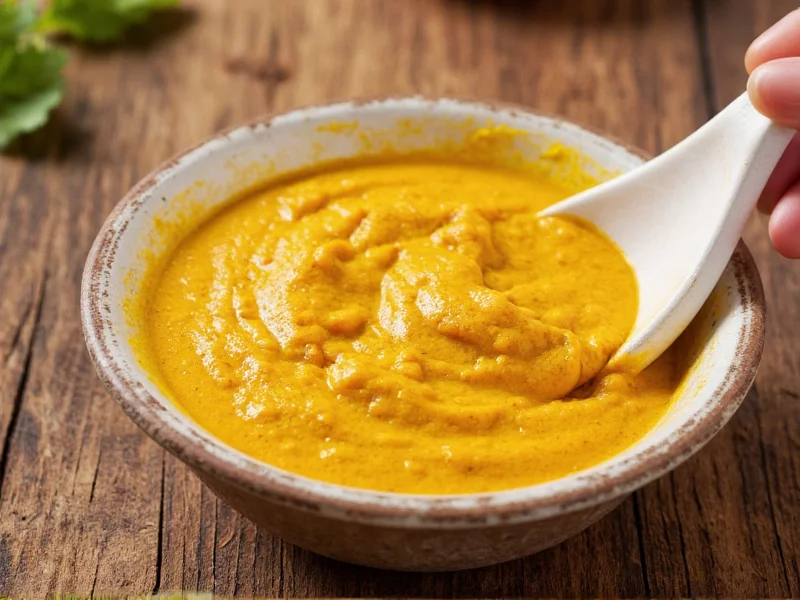Understanding how to use powdered curry sauce effectively transforms your cooking experience. This versatile pantry staple provides consistent flavor without refrigeration requirements, making it ideal for meal preppers and home chefs seeking authentic curry flavors with minimal effort. Unlike traditional curry pastes that require refrigeration after opening, powdered versions maintain quality for months when stored properly.
What Exactly Is Powdered Curry Sauce?
Powdered curry sauce consists of carefully balanced dried spices, herbs, and thickeners that recreate traditional curry flavors when combined with liquid. Manufacturers dehydrate fresh curry ingredients through specialized processes that preserve flavor compounds while removing moisture. The resulting powder contains turmeric, coriander, cumin, fenugreek, chili peppers, and other region-specific spices depending on the curry type.
Unlike curry paste—which contains fresh ingredients, oil, and moisture—powdered versions eliminate the need for preservatives while maintaining flavor integrity. This dehydration process creates a shelf-stable product that doesn't require refrigeration until reconstituted, solving common problems with traditional curry bases that spoil quickly after opening.
Powdered Curry Sauce vs. Paste vs. Ready-Made Sauce
| Characteristic | Powdered Curry Sauce | Curry Paste | Ready-Made Sauce |
|---|---|---|---|
| Shelf Life (unopened) | 18-24 months | 12-18 months | 9-12 months |
| Refrigeration Needed After Opening | No | Yes | Yes |
| Flavor Concentration | High (requires reconstitution) | Medium-High | Low-Medium |
| Storage Space Required | Minimal | Moderate | Significant |
| Customization Potential | High | Moderate | Low |
Proper Preparation Techniques for Perfect Results
Mastering how to use powdered curry sauce requires understanding the reconstitution process. The ideal ratio is typically 2 tablespoons of powder to 1 cup of liquid, though this varies by brand and desired thickness. For authentic flavor development, follow these professional techniques:
- Dry bloom the powder: Heat the powder in your cooking vessel with a small amount of oil for 1-2 minutes before adding liquid. This activates flavor compounds through the Maillard reaction.
- Gradual liquid incorporation: Add warm (not boiling) liquid slowly while whisking to prevent clumping and ensure even dispersion.
- Simmering time: Allow the reconstituted sauce to simmer for 10-15 minutes to fully develop flavors and thicken properly.
- Acid balance: Finish with a splash of citrus juice or vinegar to brighten flavors that may become muted during dehydration.
Many home cooks make the mistake of simply mixing powder with cold liquid and serving immediately. This approach fails to develop the complex flavor layers that proper preparation creates. Understanding the science behind reconstituting powdered curry sauce makes the difference between adequate and exceptional results.
Avoiding Common Powdered Curry Sauce Mistakes
Even experienced cooks encounter issues when working with powdered curry products. These frequent problems and solutions will help you achieve restaurant-quality results:
- Clumping during mixing: Always create a slurry with a small amount of cold liquid before adding to hot mixtures. Whisk vigorously during initial incorporation.
- Bland flavor profile: The dry blooming step is crucial—skipping it leaves flavor compounds underdeveloped. Consider adding complementary fresh aromatics like ginger or garlic.
- Incorrect thickness: Adjust liquid ratios based on your specific powder. Some formulations require more liquid than others due to varying starch content.
- Overpowering heat: If your sauce becomes too spicy, add dairy (coconut milk works well) or a touch of sweetness rather than more liquid, which dilutes flavor.
Storage Guidelines for Maximum Freshness
Proper storage significantly extends the shelf life of powdered curry sauce while maintaining flavor integrity. Follow these storage tips for optimal results:
- Keep in an airtight container away from light, heat, and moisture
- Store in a cool, dark pantry rather than near the stove or sink
- Use within 12 months of opening for peak flavor (though safe beyond this)
- Consider dividing large quantities into smaller containers to minimize air exposure
- Never return unused powder to the original container after contact with moisture
Unlike their paste counterparts, properly stored powdered curry sauces maintain consistent quality without refrigeration. This makes them ideal for emergency food supplies, camping, or international shipping where temperature control is challenging.
Simple Recipe Applications
Understanding how to incorporate powdered curry sauce into everyday cooking expands your culinary possibilities. These straightforward applications demonstrate its versatility:
Quick Chicken Curry (20 minutes)
Mix 3 tablespoons curry powder with 1 cup coconut milk and ½ cup broth. Brown 1½ pounds chicken pieces, then add the sauce mixture and simmer 15 minutes. Finish with fresh cilantro and a squeeze of lime. This method for using powdered curry sauce creates a restaurant-quality dish with minimal effort.
Vegetable Stir-Fry Enhancement
Create an instant stir-fry sauce by whisking 2 tablespoons curry powder with ¼ cup soy sauce, 2 tablespoons honey, and ½ cup broth. Toss with cooked vegetables and protein for an Asian-Indian fusion dish that showcases how to use powdered curry sauce beyond traditional applications.
Curry-Spiced Roasted Vegetables
Combine 2 tablespoons curry powder with 3 tablespoons oil and coat vegetables before roasting. The powder adheres better than wet pastes during high-heat cooking, creating evenly seasoned results without sogginess.
Expert Tips for Culinary Success
Professional chefs leverage powdered curry sauce in ways that maximize flavor while minimizing effort. Incorporate these advanced techniques:
- Layer flavors: Use the powder at multiple stages—bloom initially, then add a small amount near the end for brighter top notes
- Create custom blends: Mix different curry powders to develop unique flavor profiles tailored to specific dishes
- Thickening alternative: Use the powder as a gluten-free thickener for soups and stews while adding flavor
- Marinade booster: Add to yogurt or oil-based marinades for deeper flavor penetration
When substituting powdered curry sauce for paste, remember that paste contains oil and moisture that powder lacks. For every tablespoon of paste called for, use 1½ teaspoons powder plus ½ teaspoon oil. This adjustment for powdered curry sauce vs paste maintains proper flavor balance and texture in your dishes.











 浙公网安备
33010002000092号
浙公网安备
33010002000092号 浙B2-20120091-4
浙B2-20120091-4